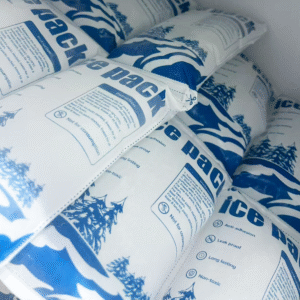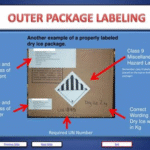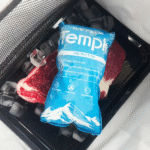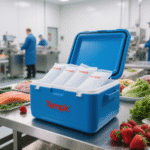Cómo utilizar bolsas de hielo seco para el envío de mariscos: Una guía completa
Shipping seafood requires careful attention to temperature control. Para garantizar que sus productos del mar lleguen a su destino frescos y seguros para el consumo, Las bolsas de hielo seco son una herramienta esencial. Estos paquetes son particularmente beneficiosos cuando se envían productos del mar a largas distancias., donde mantener una temperatura fría es fundamental. This guide explores how to use dry ice packs for seafood and ensures the best shipping practices.
-
Por qué las bolsas de hielo seco son cruciales para el envío de productos del mar.
-
Cómo seleccionar la bolsa de hielo seco adecuada para sus envíos de productos del mar.
-
¿Qué medidas de seguridad debes seguir al utilizar hielo seco??
-
¿Cuáles son los beneficios de usar bolsas de hielo seco sobre otras opciones de enfriamiento??
¿Por qué utilizar bolsas de hielo seco para enviar mariscos??
Las bolsas de hielo seco ofrecen una solución eficaz para mantener bajas temperaturas durante el transporte de productos del mar. hielo seco, que es dióxido de carbono sólido (Co₂), se sublima a -78,5°C, creating a cooling effect that is perfect for seafood, which needs to stay frozen or at a low temperature to prevent spoilage. Eligiendo la bolsa de hielo seco adecuada, you can ensure that the seafood stays fresh from point A to point B.
The main benefit of dry ice for seafood shipping is its ability to keep the contents cold without the need for refrigeration. A diferencia del hielo convencional, El hielo seco no se derrite en el agua, which eliminates the risk of wet packaging that could damage seafood. Además, dry ice can maintain the required low temperatures for extended periods, haciéndolo ideal para envíos de larga distancia.
| Característica | Descripción | Benefits for Seafood |
|---|---|---|
| Rango de temperatura | -78.5°C | Keeps seafood frozen during long shipments |
| Tasa de sublimación | 5-10 libras cada 24 horas | Ensures consistent temperature control |
| Regulaciones de envío | Subject to DOT and IATA rules | Compliant with safety standards |
Choosing the Right Dry Ice Pack for Seafood
Al enviar mariscos, selecting the correct dry ice pack is essential. The ideal pack size depends on the type and volume of seafood, as well as the shipping time. Generalmente, larger quantities of seafood require larger packs to ensure temperature control throughout the transit period.
Para envíos al día siguiente, a smaller dry ice pack might suffice, as it will keep the seafood chilled for 24-48 horas. Para tiempos de envío más largos, use larger packs to provide consistent cooling over extended periods. Multiple smaller packs can also be used to optimize cooling performance. For delicate seafood types like oysters or fish, additional insulation or multiple dry ice packs may be necessary to maintain a stable temperature.
Best Practices for Using Dry Ice Packs in Seafood Shipping
-
Understand your seafood’s temperature needs: Different seafood requires different temperature controls. Por ejemplo, shrimp may need a colder environment than other types of fish.
-
Calculate the amount of dry ice needed: Consider the shipping duration and ambient temperature. Generalmente, the more dry ice you use, the longer your products will stay cold.
-
Asegurar un embalaje adecuado: Use insulated containers to maximize the cooling effect of dry ice. The packaging should also be vented to allow the sublimation gases to escape safely.
How Do Dry Ice Packs Keep Seafood Fresh?
Dry ice packs work by sublimating into carbon dioxide gas, Absorber calor del ambiente circundante.. The solid dry ice turns into gas, creating a cooling effect that lowers the temperature of the seafood and keeps it frozen.
The cooling effect lasts longer than regular ice because dry ice doesn’t melt into water, preventing seafood from getting wet. It’s especially useful for shipping frozen seafood over long distances, as it maintains consistent temperatures until delivery.
Escenario de ejemplo
When shipping lobster or crab, dry ice can maintain the necessary freezing temperatures while ensuring that the seafood does not thaw during transit. This is especially crucial for maintaining the texture and flavor of the products.
Safety Measures When Using Dry Ice
Si bien el hielo seco es muy eficaz, it requires proper handling to ensure safety. Here are the key safety precautions:
-
Ventilación: El hielo seco libera dióxido de carbono, which can be dangerous in poorly ventilated areas. Always store and ship dry ice in well-ventilated containers.
-
Equipo de protección: Handle dry ice with insulated gloves to prevent frostbite from contact with the extremely cold material.
-
Embalaje y etiquetado: Ensure that your packaging is durable and that you label the package as containing dry ice. Proper labeling helps carriers handle shipments with care.
| Consideración de seguridad | Acción | Por qué es importante |
|---|---|---|
| Ventilación | Use in well-ventilated spaces | Prevenir la acumulación de CO₂, que puede ser peligroso |
| Equipo de protección | Wear gloves when handling dry ice | Prevent frostbite and injuries |
| Embalaje & Etiquetado | Use vented containers and label properly | Ensure safe handling and compliance with regulations |
2025 Tendencias en el transporte marítimo de productos del mar
The seafood shipping industry is evolving with the development of new technologies and strategies aimed at improving cold chain logistics. Here are some of the trends for 2025:
Monitoreo de temperatura inteligente
Using sensors that track the temperature of seafood shipments in real-time. This helps ensure that the product remains at the required temperature throughout transit.
Embalaje sostenible
As environmental concerns increase, companies are moving towards eco-friendly and biodegradable packaging solutions, reducing the carbon footprint of shipping processes.
Innovations in Shipping Technologies
-
Temperature-Sensitive Packaging: Advances in packaging materials help retain low temperatures for longer periods, providing more reliable and cost-effective solutions.
-
Blockchain para la trazabilidad: Blockchain technology ensures greater transparency and traceability in the cold chain, helping businesses confirm that seafood was handled properly during the shipping process.
Ideas del mercado
As consumer demand for fresh and sustainable seafood grows, businesses are investing in better cold chain solutions. The global cold chain market is expected to exceed $700 mil millones por 2025, driven by advancements in refrigeration and packaging technologies.
Preguntas frecuentes
Q1: What is the best way to pack seafood with dry ice?
Always use an insulated container with proper ventilation for dry ice. Ensure that the seafood is tightly packed and doesn’t move around, as movement can cause thawing.
Q2: ¿Cuánto tiempo mantendrá el hielo seco los mariscos congelados durante el envío??
El hielo seco puede mantener los mariscos congelados hasta por 48 horas, depending on the size of the pack and the ambient temperature. Larger packs are recommended for longer shipping durations.
Conclusión y recomendaciones
En resumen, dry ice packs are a crucial element for shipping seafood, ensuring it stays fresh and safe for consumption. By choosing the right size and following safety guidelines, you can ensure that your seafood shipments arrive in perfect condition.
Siguientes pasos:
-
Choose the appropriate size dry ice pack for your seafood shipment.
-
Ensure all safety protocols are followed when handling and packaging dry ice.
-
Invest in advanced monitoring technology to track temperatures during transit.
Acerca de Tempk
Y tempk, we specialize in providing reliable dry ice packs tailored to the seafood industry. With years of experience and a commitment to high-quality solutions, we help ensure your seafood shipments are fresh, seguro, and delivered on time.
























